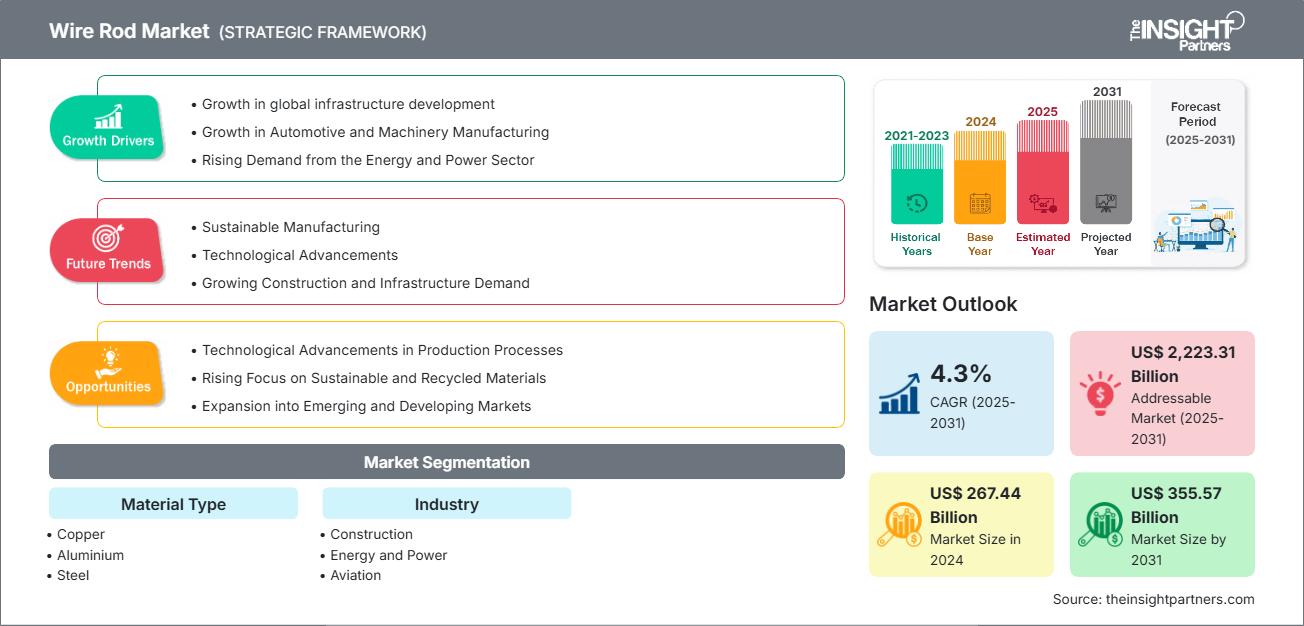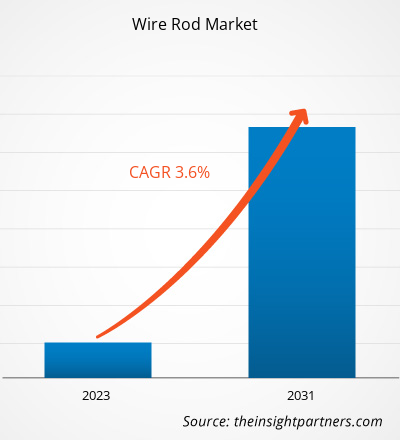Der Markt für Walzdraht wird Prognosen zufolge bis 2031 ein Volumen von 355,57 Milliarden US-Dollar erreichen, gegenüber 267,44 Milliarden US-Dollar im Jahr 2024. Es wird erwartet, dass der Markt im Zeitraum 2025–2031 eine durchschnittliche jährliche Wachstumsrate (CAGR) von 4,3 % verzeichnen wird.
Walzdrahtmarktanalyse
Der Walzdrahtmarkt wird von mehreren miteinander verknüpften Faktoren angetrieben, die die Nachfrage ankurbeln und das Branchenwachstum prägen. Ein Haupttreiber ist der zunehmende Einsatz von Walzdraht in wichtigen Endverbraucherbranchen wie dem Bauwesen, der Automobilindustrie und dem Infrastrukturausbau. Darüber hinaus erfordert die fortschreitende Urbanisierung und der Infrastrukturausbau weltweit, insbesondere in Schwellenländern wie China und Indien, einen hohen Verbrauch an Walzdraht zur Bewehrung von Betonkonstruktionen, zur Herstellung von Metallprodukten und zur Produktion von Stahldrähten. Diese anhaltende Nachfrage aus dem Bausektor ist grundlegend für das Marktwachstum.
Walzdrahtmarktübersicht
Walzdraht sind lange, gewickelte Stahlstangen mit relativ kleinem Durchmesser, die durch Warmwalzen hergestellt werden. Aufgrund ihrer Vielseitigkeit, hohen Festigkeit, Duktilität und Flexibilität dienen sie als grundlegender Rohstoff in verschiedenen Industrien. Walzdraht, typischerweise aus Stahl gefertigt, ist ein wesentlicher Bestandteil der Herstellung einer breiten Palette von Produkten und Bauteilen. Im Bauwesen wird Walzdraht häufig zur Herstellung von Schweißdraht, Stahlmatten, Bindedraht und Bewehrungsstäben verwendet und trägt zur Stabilität und Zugfestigkeit von Gebäuden, Brücken und anderen Infrastrukturprojekten bei. Auch in der Automobilindustrie ist Walzdraht unverzichtbar für die Fertigung robuster und langlebiger Komponenten wie Fahrwerksfedern und Bremsseile. In der Elektro- und Elektronikindustrie wird Walzdraht aufgrund seiner Leitfähigkeit und gleichbleibenden Qualität zur Herstellung von Kabeln und Leitungen etc. eingesetzt.
Sie erhalten eine kostenlose Anpassung aller Berichte – einschließlich Teilen dieses Berichts, Länderanalysen und Excel-Datenpaketen – sowie attraktive Angebote und Rabatte für Start-ups und Universitäten.
Walzdrahtmarkt: Strategische Einblicke

-
Ermitteln Sie die wichtigsten Markttrends dieses Berichts.Diese kostenlose Probe beinhaltet eine Datenanalyse, die von Markttrends bis hin zu Schätzungen und Prognosen reicht.
Walzdrahtmarkt und Chancen
Markttreiber:
- Wachstum im globalen Infrastrukturausbau: Der Ausbau der öffentlichen Infrastruktur, darunter Brücken, Eisenbahnstrecken und Autobahnen, hat die Nachfrage nach Walzdraht angekurbelt. Volkswirtschaften wie Indien und Indonesien treiben Bauprojekte mit staatlicher Unterstützung massiv voran und schaffen so eine starke Absatzbasis für Walzdraht.
- Wachstum in der Automobil- und Maschinenbauindustrie: Automobilhersteller und Industrieanlagenhersteller erhöhen ihre Produktionskapazitäten und setzen auf hochfeste Werkstoffe, wodurch sich erhebliche Chancen für Walzdraht ergeben, der in Befestigungselementen, Lagern und Federn verwendet wird.
- Steigende Nachfrage aus dem Energie- und Stromsektor: Walzdraht ist unerlässlich für die Herstellung von Kabeln, Leitern und verschiedenen mechanischen Bauteilen, die in der Energieerzeugung und im Netzausbau eingesetzt werden. Da der weltweite Energieverbrauch weiter steigt, wird auch die Nachfrage nach zuverlässigen Walzdrahtprodukten in naher Zukunft weiter zunehmen.
Marktchancen:
- Technologische Fortschritte in Produktionsprozessen: Hersteller, die in Automatisierung, sensorgestützte Qualitätskontrolle und umweltfreundliche Produktionssysteme investieren, können eine bessere Energieausnutzung und reduzierte Emissionen erreichen – wichtige Unterscheidungsmerkmale bei der Gewinnung von Großaufträgen der Industrie.
- Zunehmender Fokus auf nachhaltige und recycelte Materialien: Hersteller, die recycelten Stahl oder kohlenstoffarme Produktionsverfahren einsetzen, werden von Aufsichtsbehörden und Kunden gleichermaßen zunehmend bevorzugt. Dies eröffnet umweltbewussten Herstellern Marktchancen zum Aufbau von Markenbekanntheit.
- Expansion in Schwellen- und Entwicklungsländer: Die rasante Industrialisierung, die zunehmende Urbanisierung und steigende ausländische Direktinvestitionen im verarbeitenden Gewerbe treiben die lokale Nachfrage nach Walzdrahtprodukten an. Der strategische Markteintritt in Schwellenländer wie Asien stärkt die globale Marktpräsenz erheblich.
Marktsegmentierungsanalyse für Walzdraht
Der globale Walzdrahtmarkt wird segmentiert, um einen besseren Überblick über seine Funktionsweise, sein Wachstumspotenzial und die neuesten Trends zu ermöglichen. Nachfolgend ist der in den meisten Branchenberichten verwendete Standard-Segmentierungsansatz dargestellt:
Nach Materialart
- Kupfer: Kupfer ist aufgrund seiner außergewöhnlichen elektrischen und thermischen Leitfähigkeit ein dominierender Werkstoff auf dem Walzdrahtmarkt.
- Aluminium: Das hohe Verhältnis von Leitfähigkeit zu Gewicht macht es ideal für elektrische Übertragungsleitungen, Freileitungen und groß angelegte Stromverteilungsprojekte.
- Stahl: Stahl ist ein vielseitiger und weit verbreiteter Werkstoff auf dem Walzdrahtmarkt, der wegen seiner hohen Zugfestigkeit, Haltbarkeit und mechanischen Robustheit geschätzt wird.
Nach Branchen
- Bauwesen (Kupfer, Aluminium und Stahl): Die Bauindustrie ist einer der größten Abnehmer von Walzdraht, vor allem aufgrund seiner entscheidenden Rolle bei der Bewehrung von Betonkonstruktionen.
- Energie und Strom (Kupfer, Aluminium und Stahl): Das Segment Energie und Strom stellt eine zentrale Endverbraucherbranche innerhalb des globalen Walzdrahtmarktes dar, insbesondere im Hinblick auf die Verwendung von Kupfer-, Aluminium- und Stahlwalzdraht.
- Luftfahrt (Kupfer, Aluminium und Stahl): Die Luftfahrtindustrie benötigt Hochleistungsmaterialien, die extremen Betriebsbedingungen standhalten können, wodurch Walzdraht zu einer kritischen Komponente bei der Flugzeugherstellung und -wartung wird.
- Automobilindustrie (Kupfer, Aluminium und Stahl): Die Nachfrage nach Walzdraht in der Automobilindustrie wird durch den Bedarf an Werkstoffen getrieben, die eine hohe Zugfestigkeit, Dauerfestigkeit und Korrosionsbeständigkeit bei gleichzeitiger Kosteneffizienz bieten.
- Andere (Kupfer, Aluminium und Stahl): Walzdraht findet in zahlreichen weiteren Branchen breite Anwendung, darunter Energie, Maschinenbau, Eisenbahnwesen, Schiffbau und Elektronik.
Nach Geographie:
- Nordamerika
- Europa
- Asien-Pazifik
- Südamerika
- Naher Osten und Afrika
Der Markt für Walzdraht im asiatisch-pazifischen Raum dürfte das schnellste Wachstum verzeichnen. Dieses Wachstum wird durch die rasante Industrialisierung und Urbanisierung in Schlüsselländern wie China, Indien und Japan angetrieben, die zusammen einen Großteil der weltweiten Walzdrahtproduktion und des -verbrauchs ausmachen.
Regionale Einblicke in den Walzdrahtmarkt
Die regionalen Trends und Einflussfaktoren auf den Walzdrahtmarkt im gesamten Prognosezeitraum wurden von den Analysten von The Insight Partners eingehend erläutert. Dieser Abschnitt behandelt außerdem die Marktsegmente und die geografische Verteilung des Walzdrahtmarktes in Nordamerika, Europa, Asien-Pazifik, dem Nahen Osten und Afrika sowie Süd- und Mittelamerika.
Berichtsumfang zum Walzdrahtmarkt
| Berichtattribute | Details |
|---|---|
| Marktgröße im Jahr 2024 | 267,44 Milliarden US-Dollar |
| Marktgröße bis 2031 | 355,57 Milliarden US-Dollar |
| Globale durchschnittliche jährliche Wachstumsrate (2025 - 2031) | 4,3 % |
| Historische Daten | 2021-2023 |
| Prognosezeitraum | 2025–2031 |
| Abgedeckte Segmente |
Nach Materialart
|
| Abgedeckte Regionen und Länder |
Nordamerika
|
| Marktführer und wichtige Unternehmensprofile |
|
Marktdichte der Walzdraht-Akteure: Auswirkungen auf die Geschäftsdynamik verstehen
Der Walzdrahtmarkt wächst rasant, angetrieben durch die steigende Nachfrage der Endverbraucher. Gründe hierfür sind unter anderem sich wandelnde Verbraucherpräferenzen, technologische Fortschritte und ein wachsendes Bewusstsein für die Vorteile des Produkts. Mit steigender Nachfrage erweitern Unternehmen ihr Angebot, entwickeln innovative Lösungen für die Bedürfnisse der Verbraucher und nutzen neue Trends, was das Marktwachstum zusätzlich beflügelt.

- Verschaffen Sie sich einen Überblick über die wichtigsten Akteure des Drahtdrahtmarktes.
Globale Marktanteilsanalyse für Walzdraht nach Regionen
Der asiatisch-pazifische Raum dürfte in den nächsten Jahren das schnellste Wachstum verzeichnen. Auch die aufstrebenden Märkte in Südamerika sowie im Nahen Osten und in Afrika bieten Walzdrahtherstellern zahlreiche ungenutzte Expansionsmöglichkeiten.
Der globale Walzdrahtmarkt entwickelt sich in den einzelnen Regionen unterschiedlich, bedingt durch Unterschiede in der wirtschaftlichen Entwicklung, der industriellen Aktivität, den Infrastrukturinvestitionen und der branchenspezifischen Nachfrage. Nachfolgend finden Sie eine Zusammenfassung der Marktanteile und Trends nach Regionen:
1. Nordamerika
- Marktanteil: Das Wachstum wird durch die Expansion der industriellen Fertigung und die steigende Nachfrage aus dem Automobil- und Baugewerbe angetrieben.
- Wichtigste Treiber: Modernisierung der Bauindustrie und zunehmende Infrastrukturentwicklung.
- Trends: Zunehmende Nutzung umweltfreundlicher Produktionsverfahren.
2. Europa
- Marktanteil: Bedeutender Marktanteil aufgrund zunehmender Infrastrukturentwicklungen.
- Wichtigste Einflussfaktoren: Die wachsende Automobilindustrie in der Region, verbunden mit Fortschritten bei den Fertigungstechnologien.
- Trends: Zunehmende Nutzung umweltfreundlicher Produktionsverfahren.
3. Asien-Pazifik
- Marktanteil: Am schnellsten wachsende Region mit jährlich steigendem Marktanteil.
- Wichtigste Einflussfaktoren: Wachstum der industriellen Fertigung in den Bereichen Maschinenbau, Baumaschinen und Elektronik, verbunden mit zunehmender Urbanisierung und Industrialisierung.
- Trends: Zunehmende Verbreitung fortschrittlicher Fertigungstechnologien.
4. Südamerika
- Marktanteil: Ein wachsender Markt mit stetigem Fortschritt, der durch die Expansion im Automobil- und Bausektor angetrieben wird.
- Wichtigste Einflussfaktoren: Steigende Nachfrage nach Hochleistungsschneidwerkzeugen in Verbindung mit wachsenden Bauprojekten und der Automobilproduktion.
- Trends: Zunehmender Einsatz von hochfesten und korrosionsbeständigen Walzdrahtstangen dank technologischer Verbesserungen
5. Naher Osten und Afrika
- Marktanteil: Das Wachstum wird primär durch die expandierende Automobilindustrie, die rasche Urbanisierung und den Infrastrukturausbau getrieben.
- Wichtigste Einflussfaktoren: Wachsende Automobilproduktion und -verkäufe, verbunden mit zunehmenden Investitionen in Projekte für erneuerbare Energien wie Solar- und Windkraft.
- Trends: Zunehmende Verwendung von Aluminiumdraht in der Automobil- und Elektroindustrie.
Marktdichte der Walzdraht-Akteure: Auswirkungen auf die Geschäftsdynamik verstehen
Hohe Marktdichte und starker Wettbewerb
Der Wettbewerb ist aufgrund der Präsenz etablierter Unternehmen wie Hindalco Industries Ltd, Mitsubishi Materials Trading Corp und Norsk Hydro ASA intensiv. Regionale und spezialisierte Anbieter wie EVRAZ North America (Nordamerika), Gerdau S/A (Brasilien), SHAGANG GROUP Inc. (China) und Nippon Steel (Japan) tragen ebenfalls zur Wettbewerbslandschaft in verschiedenen Regionen bei.
Dieser hohe Wettbewerbsdruck zwingt Unternehmen dazu, sich durch Folgendes hervorzuheben:
- Modernisieren Sie die Produktion durch den Einsatz von Automatisierung, Digitalisierung sowie KI-gestützter Prozesssteuerung.
- Investieren Sie in fortschrittliche Fertigungstechnologien wie das kontinuierliche Glühen.
- Entwicklung von Spezialdrahtstangen, die auf neue Bedürfnisse zugeschnitten sind, wie z. B. Automobilkomponenten für Elektrofahrzeuge.
Chancen und strategische Schritte
- Entwicklung kundenspezifischer Walzdrahtsorten mit fortschrittlichen Oberflächenbehandlungen für spezielle Anwendungsbereiche.
- Die Anpassung von Automatisierung, KI-gestützter Prozesssteuerung und Digitalisierung
- Erweiterung des Produktportfolios, um ein breiteres Spektrum an Branchen bedienen zu können.
Weitere im Rahmen der Studie analysierte Unternehmen:
- ArcelorMittal Stangen und Stäbe
- EVRAZ Nordamerika
- Gerdau S/A
- SHAGANG GROUP Inc.
- Nippon Steel
- Central Wire Industries
- FAGERSTA STAINLESS AB (Marcegaglia-Gruppe)
- Emirates Steel (VAE)
- Bhushan Power & Steel Limited (BPSL)
- Qingdao Ansteel Group Co., Ltd.
- CITIC Pacific Special Steel Co., Ltd
- Jiangyin Zenith Metals Co., Ltd.
- Ivaco Walzwerke
- Dubai Cable Company (Private) Limited
- Southwire Company, LLC
Neuigkeiten und aktuelle Entwicklungen auf dem Walzdrahtmarkt
- Hindalco Industries Ltd investiert in sein Aluminium-, Kupfer- und Spezialaluminiumoxidgeschäft in Indien. Das in Mumbai ansässige Metallunternehmen Hindalco Industries Ltd wird 450 Milliarden Rupien (5,21 Milliarden US-Dollar) in seine Aluminium-, Kupfer- und Spezialaluminiumoxidgeschäfte in Indien investieren.
Bericht über den Walzdrahtmarkt: Abdeckung und Ergebnisse
Der Bericht „Globaler Walzdrahtmarkt – Größe und Prognose (2021–2031)“ bietet eine detaillierte Analyse des Marktes und deckt folgende Bereiche ab:
- Weltweite Marktgröße und Prognose für Walzdraht auf globaler, regionaler und Länderebene für alle wichtigen Marktsegmente, die im Rahmen des Berichts abgedeckt werden
- Globale Markttrends für Walzdraht sowie Marktdynamiken wie Treiber, Hemmnisse und wichtige Chancen
- Detaillierte PEST- und SWOT-Analyse
- Globale Marktanalyse für Walzdraht: Wichtige Markttrends, globale und regionale Rahmenbedingungen, Hauptakteure, regulatorische Bestimmungen und aktuelle Marktentwicklungen
- Branchenlandschafts- und Wettbewerbsanalyse mit Marktkonzentration, Heatmap-Analyse, prominenten Akteuren und aktuellen Entwicklungen für den globalen Walzdrahtmarkt
- Detaillierte Unternehmensprofile
- Historische Analyse (2 Jahre), Basisjahr, Prognose (7 Jahre) mit CAGR
- PEST- und SWOT-Analyse
- Marktgröße Wert/Volumen – Global, Regional, Land
- Branchen- und Wettbewerbslandschaft
- Excel-Datensatz
Aktuelle Berichte
Verwandte Berichte
Erfahrungsberichte
Grund zum Kauf
- Fundierte Entscheidungsfindung
- Marktdynamik verstehen
- Wettbewerbsanalyse
- Kundeneinblicke
- Marktprognosen
- Risikominimierung
- Strategische Planung
- Investitionsbegründung
- Identifizierung neuer Märkte
- Verbesserung von Marketingstrategien
- Steigerung der Betriebseffizienz
- Anpassung an regulatorische Trends






















 Kostenlose Probe anfordern für - Walzdrahtmarkt
Kostenlose Probe anfordern für - Walzdrahtmarkt